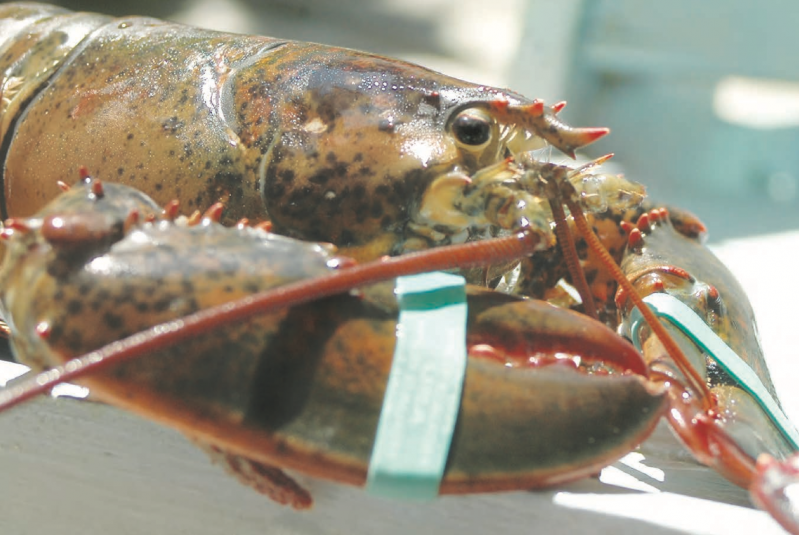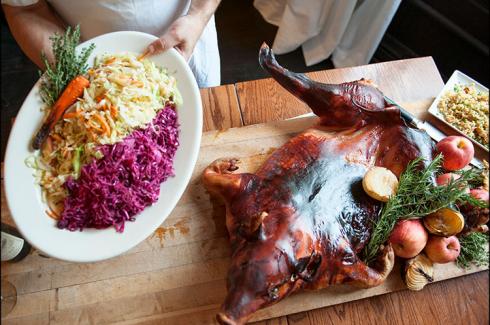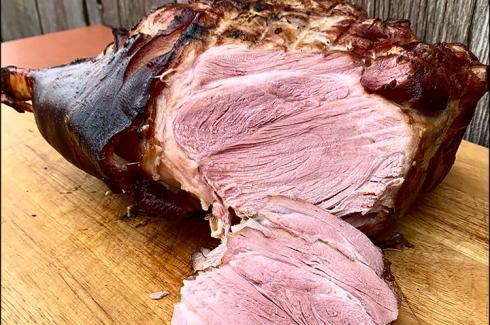What could be better than a summer meal of lobster, corn, and tomatoes? The lobster and corn merely need to be steamed and perhaps buttered generously, the tomatoes sliced and dressed. Couldn’t be simpler.
American lobster or Homarus americanus hasn’t always been considered such a coveted delicacy. In 18th-century Maine, it was used for fertilizer. In 19th-century Europe, the oyster was considered a much more luxurious treat, and lobsters were referred to as poor men's food.
The European lobster (Homarus gammarus) is slightly smaller, a darker color, and its claws aren’t quite as menacing as the American’s. European lobsters can be found from the far north down to the Mediterranean. American lobsters can be found in shallower waters (especially in rocky areas where they can hide) from Labrador, Canada, to North Carolina. It is unlikely that you have tried a European lobster in America; they are too scarce. American lobsters, however, are exported in large numbers to Europe. Frozen lobster tails are not true American lobster, they are usually from rock or spiny lobsters and are a bit tougher.
In case you ever feel guilty about dropping these live creatures into a pot of boiling water, allow me to remind you of their background. Lobsters (along with crayfish, crabs, shrimp, and prawns) are shellfish that have legs and sometimes claws. They are members of the animal group arthropods, and their nearest relatives are insects. In fact, their bodies are similar to insects in that their outer shell (or exoskeleton) is used to protect other segments of the body. Since they are mobile, carnivorous, and cannibalistic, they are not very good candidates for farming, unlike their legless mollusk relatives.
There are various theories about the kindest way to kill a lobster, one of which is to jab it in the brain with a sturdy, sharp chef’s knife and split the head in half. Sound humane? Hardly. I would prefer to go with the marine biologists’ method of anesthetizing the lobster by soaking it in iced salt water for 30 minutes before cooking. Do not, however, store lobsters in water. They should simply be refrigerated with a layer of wet newspaper or seaweed over them, and for no more than a day or two.
It is important to try to find feisty lobsters. If they are lethargic or foamy, or the tank they are in looks a bit cloudy, steer clear. If left in a tank for too long, lobsters begin to waste away within their shells. The reason that it is essential to consume lobsters as soon as possible is the liver. Considered the most important organ in the lobster (and one of the most delicious parts), it breaks down rapidly when the lobster is killed.
You also want to avoid lobsters that appear to have recently molted their shells. This is why wild harvests are seasonal. (Eighty percent of New England’s harvest is from July to October.) An active growing lobster has dense, abundant flesh, whereas one preparing to molt loses muscle and liver, and one that has just finished molting is filled with water.
There is always a debate over size. I have eaten those monster Palm restaurant-type lobsters and the little bitty chicken or culls and they have all varied in tenderness and sweetness.
Some feel strongly that the female lobster is better. It is plumper, and the mature females carry delicious green roe that turns coral red when cooked. To tell the difference between male and female, flip the lobster over and check the first set of feelers below the thorax. They are soft on the female, hard on the male. The females also have shorter and wider tails.
Cooking time for lobster is also controversial. I prefer to steam small lobsters for only about 10 to 12 minutes. Perhaps this sounds peculiar, but I like to use unsalted butter, which I salt after it’s melted. And lots of fresh lemon wedges!
Local prices for lobsters have gone up, but not astronomically. Whenever I see a sign at the Seafood Shop in Wainscott or Round Swamp Farm in East Hampton offering three or four for a reasonable price, I will take advantage. Three lobsters for $42 doesn’t sound so bad when you compare it to the price of a dinner at just about any restaurant out here. And with the luxury of having leftover lobster the next day, you can whip up some lobster rolls or fold the leftover meat into an omelette or some risotto.
Although lobster has a delicate sweet taste, it goes well with many other flavors such as basil, shallots, sherry, truffle, cream, dill, brandy, and tomato. There is even a popular fad right now of saucing lobster with vanilla! Whichever way you choose to prepare this somewhat luxurious delicacy, enjoy the short season that is available to us.
Lobster Newburg
Long, long ago, Delmonico's in New York City was the place to eat and drink. This is where chicken a la king (originally chicken a la Keene) and lobster New- burg were created and named after favorite patrons. One patron, Ben Wenberg, showed Lorenzo Delmonico a dish he had tried in South America. Rich and creamy, served over toast or rice, it became a great hit. Unfortunately, Mr. Wenberg got into a brawl at Delmonico's, which caused him to be banned forever, and the dish Lobster Wenberg had its name changed to lobster Newburg.
Here is a version of the dish from the L.V.I.S. 60th anniversary cookbook:
1 lb. lobster meat, cooked
3 Tbsp. butter
1 Tbsp. flour
1 cup sherry
1 cup heavy cream
3 egg yolks, beaten
Salt and pepper
Toast or cooked rice for serving
Cut lobster into small pieces, melt butter, and blend in flour, and heat for five minutes. Add wine and simmer slowly. Beat cream into egg yolks, add lobster, and season. Cook, stirring constantly until it thickens. Serve at once on top of crisp toast.
Lobster Noodles
I’m afraid I don’t recall where this recipe came from. It is on an old Xerox copied from a magazine. Lobster and crab meat have a great affinity for sharp Asian ingredients like ginger and garlic. Serves four
1/2 cup chicken stock
1 1/2 Tbsp. fermented black bean paste
2 tsp. sesame oil, divided
1 1/2 tsp. cornstarch
1/2 tsp. salt
2 Tbsp. vegetable oil
2 large garlic cloves, minced
1 Tbsp. minced ginger
1 1/4 lb. cooked lobster meat
1/2 lb. Asian noodles, such as lo mein, rice noodles, or cellophane noodles, cooked
2 scallions, chopped
In small bowl combine chicken stock, bean paste, one teaspoon sesame oil, cornstarch, and salt; set aside.
Heat oil in wok or large skillet over medium-high heat. Add garlic and ginger and sauté until fragrant, about 30 seconds. Add chicken stock mixture and lobster. Sauté until lobster is heated through and sauce has thickened, about three minutes. Toss noodles with remaining sesame oil.
To serve, place noodles on platter, spoon lobster with sauce over noodles, and sprinkle with scallions.





